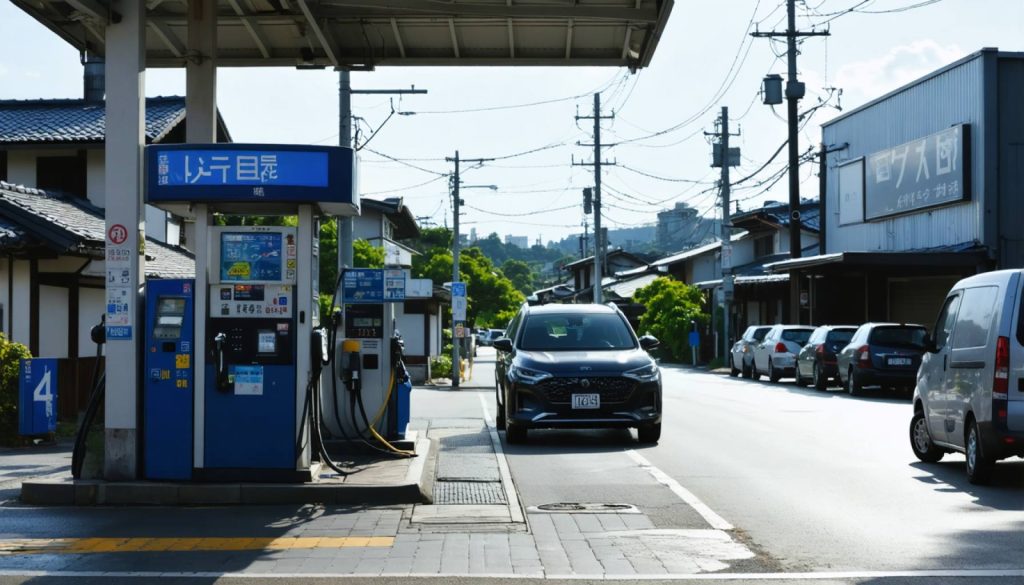
- Japan’s fuel tax significantly influences environmental, social, and economic landscapes by encouraging sustainable practices.
- The tax supports investments in public transportation, promoting the use of electric cars and bicycles over traditional vehicles.
- Funds from the fuel tax are used to enhance infrastructure, reinforcing Japan’s global leadership in safety and innovation.
- Challenges arise in rural areas with limited public transport, highlighting the need for nuanced policy approaches.
- The fuel tax balances economic growth with environmental sustainability and infrastructure advancement.
- Overall, the tax reflects Japan’s commitment to progress and responsibility, pushing the nation towards a sustainable future.
In the bustling streets of Tokyo, where neon lights blur into a mosaic of colors and the rhythmic hum of engines fills the air, the subtle influence of Japan’s fuel tax quietly shapes the country’s landscape. With every liter of fuel purchased, a small yet significant portion is meticulously allocated as a tax. This seemingly simple policy orchestrates a symphony of consequences, both seen and unseen, that ripple through society.
At first glance, the fuel tax might appear as just another government imposition. Yet, dig beneath the surface, and its impact reveals a complex tapestry that weaves through Japan’s commitment to environmental stewardship, social welfare, and economic strategy. The tax itself is a tool, designed to nudge a nation increasingly aware of its carbon footprint into adopting cleaner practices.
Walking through a Tokyo suburb, one can witness the tangible effects: compact electric cars hum silently down narrow lanes, while bicycles outnumber traditional vehicles. The fuel tax, among other initiatives, incentivizes the population to explore sustainable alternatives. Japan’s investment in public transportation blossoms here, with bullet trains and metro systems offering efficient and eco-friendly options that allow commuters to bypass their reliance on fuel altogether.
Beyond transportation, the fuel tax funds critical infrastructure projects. Roads and bridges are not just maintained; they are optimized for safety and efficiency. These improvements reinforce Japan’s reputation as a world leader in infrastructure. Such projects exemplify the profound role of the fuel tax in supporting an economy that prizes resilience and innovation.
However, the tax is not without its challenges. In rural regions, where public transport options are sparse and distances vast, residents feel the pinch more acutely. For the elderly farmer in Hokkaido or the fisherman in Okinawa, every yen shelled out at the pump can weigh heavily. Here, the ramifications of the tax unfold differently—emphasizing the need for policy designs that consider diverse lifestyles.
Ultimately, Japan’s fuel tax is more than a number added to a receipt. It represents a deliberate choice to balance economic growth with environmental sustainability and infrastructure advancement. As Japan continues to navigate its future, this tax stands as a symbol of its commitment to align progress with responsibility.
The takeaway is clear: Japan’s fuel tax exemplifies how fiscal policies can drive meaningful societal change. While the hum of engines still pulses through Tokyo and beyond, the rhythm steadily shifts toward a greener horizon. This transition underscores an essential ethos: every drop of fuel spent fuels not just a vehicle, but a broader vision for a sustainable tomorrow.
How Japan’s Fuel Tax is Paving the Way Towards a Greener Future
Unveiling Japan’s Fuel Tax: A Comprehensive Insight
The fuel tax in Japan is intricately woven into the country’s broader initiatives to foster environmental sustainability, bolster social welfare, and drive economic growth. While the bustling urban life of Tokyo provides one facet of the tax’s influence, a deeper exploration reveals how this fiscal tool shapes diverse aspects of Japanese life, from transportation to infrastructure development.
Economic Implications and Environmental Impact
Incentivizing Cleaner Transportation Alternatives: The fuel tax substantially nudges citizens towards adopting electric vehicles and using efficient public transportation. According to the Ministry of Land, Infrastructure, Transport and Tourism, Japan has invested heavily in the expansion of electric vehicle (EV) charging stations, directly supported by tax revenues. This investment aligns with Japan’s ambitious target to become carbon neutral by 2050.
Public Transportation Development: The revenue generated by the fuel tax aids in the continuous enhancement and maintenance of public transport systems. The Shinkansen, or bullet train, for instance, serves as a testament to Japan’s commitment to eco-friendly and high-speed travel. Government sources indicate that these trains not only offer low-emission travel options but also significantly reduce travel time, thereby increasing productivity.
Addressing Rural Challenges
Balancing Urban and Rural Needs: While urban areas benefit significantly from public transportation, rural regions face unique challenges. In areas like Hokkaido and Okinawa, where distances are greater and public transport less accessible, there is a pressing need for policy adjustments. The government is actively working on subsidies for rural households and developing alternative transport infrastructures that balance these geographical disparities.
Market Trends: Japan’s Movement Toward Sustainability
Increased Electric Vehicle Adoption: The electric vehicle market in Japan is expected to see a compound annual growth rate (CAGR) of around 21% by 2030 (Emergen Research). This growth is fueled by both consumer interest and government policy, including tax incentives and a strong push for carbon neutrality.
Infrastructure Developments: Japan is continuously enhancing roads and bridges, making them more resilient against natural disasters—a pertinent concern given the country’s susceptibility to earthquakes and typhoons. These projects are not only funded by the fuel tax but are also part of a broader strategy to ensure economic stability.
Pros, Cons, and Recommendations
Pros:
– Encourages reduced dependence on fossil fuels.
– Funds critical infrastructure and transportation projects.
– Supports Japan’s environmental goals and commitments.
Cons:
– Imposes financial strain on rural communities with fewer public transport options.
– Potentially increases the cost of goods due to higher transportation costs.
Recommendations for Policy Makers:
– Develop tailored incentives and subsidies for rural areas to alleviate financial burdens.
– Continue expanding EV infrastructure to make adoption more feasible for all demographics.
– Foster innovative solutions to improve public transport accessibility in less populated areas.
Quick Tips for Readers
1. Consider Switching to Public Transportation: Take advantage of efficient and eco-friendly options, especially in urban settings.
2. Explore Electric Vehicles: If you’re a vehicle owner, consider making the switch to an electric option that aligns with government incentives.
3. Stay Informed on Policy Changes: Understanding how tax reforms may impact your lifestyle can allow you to make financially sound decisions.
For more insights on how Japan is addressing sustainability and innovation, visit the Japan External Trade Organization.
This comprehensive understanding of Japan’s fuel tax shows how such fiscal measures not only serve economic purposes but also steer nations toward a sustainable future. As global attention shifts to climate responsibility, Japan’s model offers valuable lessons in balancing growth with ecological and social commitments.



